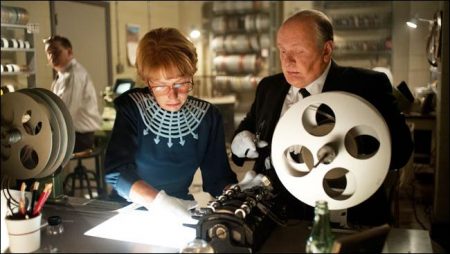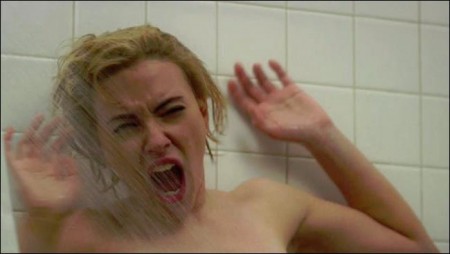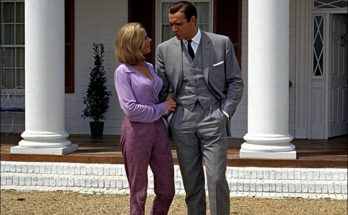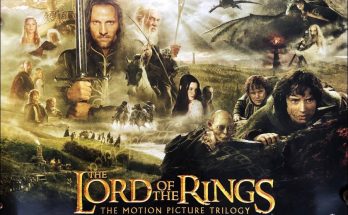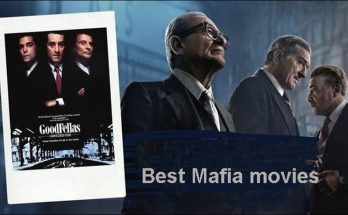The visual designs of Hitchcock movie. The visual design of Hitchcock hinged on merging two very different worlds: that of the closed Psycho film set, where the bones of Hitchcock’s trademark texture, anxiety and titillation were created, and another world even less seen, Hitchcock’s domestic home life with Alma. Gervasi worked with a highly accomplished crew including director of photography Jeff Cronenweth, production designer Judy Becker and costume designer Julie Weiss, to bring both to life.
Gervasi was drawn to two-time Oscar nominee Cronenweth because of his elegantly austere work with David Fincher on such films as Social Network and The Girl with the Dragon Tattoo. “You could learn everything you learn in film school in just one week with Jeff,” says Gervasi. “He is that assured and innovative.”
Becker, whose films include Brokeback Mountain and The Fighter, was equally key as a collaborator. She and Gervasi talked a lot about how to create a dynamic sense of period as well as a compelling reality for Alfred and Alma.
“Sacha really wanted to show Hitchcock’s home world, his domestic life, as well as his Hollywood life, so we had to look for ways to tie these together, which we did mainly through palette,” she explains. “For example, we picked a lot of 50s colors, like coral and aqua, but then you might see touches of those in Hitchcock’s very traditional English home. It was quite an intensive process.”
Since Psycho was shot in black and white, and there is no existing color photography from the shoot, Becker researched what colors might have been used to achieve the gray scale tones in the 1960 movie – but also added electrifying pops of the colors that defined mid-Century design.
“Not having a visual record could be seen as a handicap but you could also view it as enormously freeing, which I did,” says Becker.” Sacha and I decided that we wanted to make our movie set vibrant and colorful, in part to play against the viewer’s expectations since PSYCHO is so iconically black and white.”
Creating the Hitchcock home – for which an exterior on Alpine Dr. in Beverly Hills and interiors in Pasadena stood in – was more about creating a sense of partnership over time, and Becker filled the rooms with mementos from several decades, accumulated over years of working and being together. “It was important to feel that Alma and Alfred have already been married for 40 years when our film takes place, so the house incorporates a feeling of all the stuff that came before,” she says.
Once again, a primary principle was avoiding replication. Instead, Becker set out to craft a believable, dynamic environment that would bring audiences into Hitch and Alma’s living spaces. “During Psycho, the Hitchcocks actually lived in a ranch house in Bel Air, but Sacha wanted their house to look more like the Tudor they had lived in in England,”
Becker explains. “We researched their house in Bel Air quite a bit, but we departed from reality when it worked well for the story. There were also many things we were true to, including Hitchcock’s love of modern art, which is something that sort of plays against this old English house and brings it to another level.”
Becker also included subtle Hitchcock motifs in the house and in Hitchcock’s office, including birds, a species with which he was fascinated long before he made The Birds.
For Hitchcock’s office, Becker had the advantage of being able to work with the actual environs where he started developing Psycho. The Psycho sets – including the iconic bathroom, the opening-scene motel room and the parlor where Norman Bates peeks at Marian Crane though a spyhole — were then re-created on the stages at the Red Studios in Hollywood, which were dressed to depict the Universal lot of 1960, where PSYCHO was shot.
“You get a chance here to see these sets as you never saw them in the movie,” notes Becker. “And you get to see them in color for the first time, so that is part of the fun.”
Hitchcock
Directed by: Sacha Gervasi
Starring: Anthony Hopkins, Helen Mirren, Scarlett Johansson, Jessica Biel, Toni Collette, Michael Stuhlbarg, Danny Huston, James D’Arcy
Screenplay by: John J. McLaughlin
Production Design by: Judy Becker
Cinematography by: Jeff Cronenweth
Film Editing by: Pamela Martin
Costume Design by: Julie Weiss
Set Decoration by: Robert Gould
Art Direction by: Alexander Wei
Music by: Danny Elfman
MPAA Rating: PG-13 for some violent images, sexual content and thematic material.
Studio: Fox Searchlight Pictures
Release Date: November 21, 2012
Related Link: View the Full Production Notes for Hitchcock
Visits: 74
